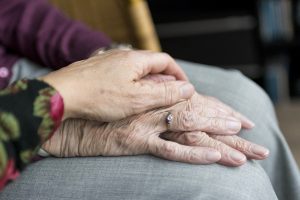2.5.3 End-of-Life Care
The care of a client entering the final stage of life will revolve around the client’s comfort and the comfort of the family at all times. The focus of care changes from modes of treatment to controlling pain, eliminating difficulty, and creating an environment where the client has maximum comfort and peace prior to death.

Several signs are noted at the end of life, as systems in the body begin to shut down. Signs include pain, fatigue, weight loss, loss of appetite, erratic sleep, and many more. These signs will begin weeks before death and will gradually become more pronounced the longer the client proceeds along the journey.
Key Takeaway
It is important to be able to recognize the signs of impending death and roughly when in the timeline they will occur. Please read “End of Life Timeline: Signs & Symptoms of the Dying Process” now for a detailed breakdown of how a person dies.
If you would like to know more about the stages that a dying person will progress through, consider watching “Death and Dying: What to Expect in the Final Stages of Life” from CBC News.
While a patient is at end-of-life stage, they will experience many problems and complaints. Review the following table, which is adapted from the Mayo Clinic (2020), which presents common problems and appropriate responses from a care provider:
| Challenge | Comfort and Care |
|---|---|
| Loss of appetite | Feed small spoonsful of soft or pureed food at a time. Use ice chips or a damp sponge to keep the mouth moist. |
| Facial dryness | Use a damp cloth around the eyes. Apply lip balm or petroleum jelly to the lips. |
| Laboured breathing | Gently turn the client’s head, adjust pillows or raise the head of the bed. Use a cool-mist humidifier. Ask your medical team about medication or the use of oxygen. |
| Irritated skin | Gently apply lotion to dry skin. Learn how to move and adjust the client safely in bed to avoid the development of sores. |
| Incontinence | Use incontinence pads or ask about the use of a catheter. |
| Agitation, confusion | Speak calmly and be reassuring. Hold hands or use a gentle touch if it’s comforting. Remind the client where he or she is and who is there. Ask your medical team for help if significant agitation occurs. |
| Pain | Give pain medication as directed. Ask your medical team to adjust medication if needed. |
| Sensitivity to temperature | Pay attention to clues to whether the client feels hot or cold. Adjust the room temperature and bedding as needed. |
(Mayo Clinic, 2020)
In Canada, Medical Aid in Dying (MAID) is legal, affording individuals with terminal or debilitating illnesses the ability to choose to end their lives medically. In Ontario, physicians and Nurse Practitioners who have chosen to offer this service can provide MAID to eligible individuals who apply and who are approved by an evaluative panel. It is possible that you may care for a client who chooses MAID, so please take a moment to familiarize yourself with the provisions and conditions of this legal right.
You may work in a facility or for an agency where MAID is provided, and you may be called upon to care for a client prior to the service being performed. It is important to be professional and caring to all clients—this includes providing care without judgment in situations where clients are making choices about their lives you may find conflicting with your views. Your focus is always to provide the best care for your client.
Did You Know?
If you would like more insight into MAID and those who choose it, please consider visiting the Dying With Dignity website. Here, you will find many resources to do with MAID, including a blog where people who have chosen MAID themselves, or whose family members have done so tell their stories firsthand.

